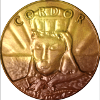On the efficient usage of Drowic plural pronouns by ''Eclavdra''
From: N'unyabusy'nez'hrad
To: Andunor Trade Hub Public Message Board
- several small postage stamps can be seen on the letter, some are of obscure origin, however featuring spiderweb motifs while others may be recognized as those of Gracklstugh
[Undercommon]:
This cycle I encountered a situation when a group of theatre males was referred to as "they", which lead to some confusion whether they were accompanied by a female or not (I was with them). The confusion was resolved quite fast
but it reminded me of the flaws and limitations of the degenerate form of the Language that is used.
Quite often in daily life, we refer to groups of people, creatures, or objects using plural pronouns that lack nuance regarding the gender composition and animacy of the group. Yet such information is of course important and relevant: are we speaking of an all-male group, a herd of rothe of mixed sexes, or a gathering of children - and are they accompanied by a female?
This issue is, of course, easily and elegantly resolved by the usage of the gender-conditioned plural pronouns.
The distinct forms for that reveal the gender makeup of the group. In this system, usual "they" pronoun is used for any groups that contain at least one feminine animate referent, whereas "thaey" is to be used for the rest of the groups that feature no feminine animate referents.
Quite simple and informative.
When we say "they" - we mean that the group we are referring to has at least one female, when we say "thaey" - we indicate that the group we are talking about has no females.
Some examples:
Two Priestesses are "they".
Two theatre males are "thaey".
Five theatre males and me are "they".
Ten toddlers of various genders with a pet lizard are "thaey".
A bunch of Xun'viirs are "thaey".
A million males and another million of male toddlers accompanied by single priestess is "they".
Or more personalized:
Szorn and Szordrin are "thaey".
Szorn, Szordrin and Araj are "they".
Vaskira and Phyra are "thaey".
Vaskira and Indis are "they".
Simple right?
Let's be mindful of each others time and use the language efficiently.
- Same is repeated in so-called Xanalress or "the Language"*
[Xanalress]:
This cycle I encountered a situation when a group of theatre males was referred to as "they", which lead to some confusion whether they were accompanied by a female or not (I was with them). The confusion was resolved quite fast
but it reminded me of the flaws and limitations of the degenerate form of the Language that is used.
Quite often in daily life, we refer to groups of people, creatures, or objects using plural pronouns that lack nuance regarding the gender composition and animacy of the group. Yet such information is of course important and relevant: are we speaking of an all-male group, a herd of rothe of mixed sexes, or a gathering of children - and are they accompanied by a female?
This issue is, of course, easily and elegantly resolved by the usage of the gender-conditioned plural pronouns.
The distinct forms for that reveal the gender makeup of the group. In this system, usual "they" pronoun is used for any groups that contain at least one feminine animate referent, whereas "thaey" is to be used for the rest of the groups that feature no feminine animate referents.
Quite simple and informative.
When we say "they" - we mean that the group we are referring to has at least one female, when we say "thaey" - we indicate that the group we are talking about has no females.
Some examples:
Two Priestesses are "they". Two theatre males are "thaey". Five theatre males and me are "they". Ten toddlers of various genders with a pet lizard are "thaey". A bunch of Xun'viirs are "thaey". A million males and another million of male toddlers accompanied by single priestess is "they".
Or more personalized:
Szorn and Szordrin are "thaey". Szorn, Szordrin and Araj are "they". Vaskira and Phyra are "thaey". Vaskira and Indis are "they".
Simple right?
Let's be mindful of each others time and use the language efficiently.
P.S. For second person of non-feminine-animate groups you can use simple "u", whereas "you" is for groups with at least on female.
Day 7, Month 2 (Alturiak), 187 AR (1387 DR)
Eclavdra
